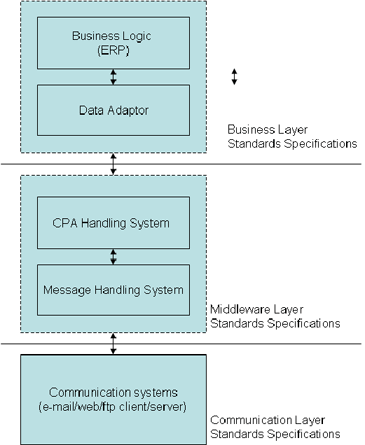![[PRECEDENTE]](/ebiz/images/but_previous.gif)
![[INDICE]](/ebiz/images/but_up.gif)
![[PRINT]](/ebiz/images/but_print.gif)
|
Middleware and communication layers
An overview
The section introduces the idea of an European Textile Clothing and Footwear Network (ETCFN), a virtual eBusiness network, where the business level communication is based on the harmonised standards specifications (described above), and for which we make some recommendations regarding physical communications in order to achieve an optimum mix between flexibility and interoperability.
The approach of eBiz-TCF project
The middleware and communication layers are not sector-specific, they concern the communication systems and applications in general. It is out of the scope of the project eBiz-TCF to harmonise the existing standards at these levels, as well as to define precise guidelines of how to use existing standards in order to obtain interoperability (standard profiling).
The schema below shows which standards are recommended within the project. The following three basic approaches have been adopted:
Abstract content models, best practices and examples are presented for each of the three approaches in Appendices D and E . The SOAP-based data models for the ebXML and SMTP/POP-based approaches have undergone a first harmonisation, and have the same content. Note that FTP protocols are not included in the communication layer of the architecture, due to the difficulties related to them in tracking message sending and receiving. eBusiness and Messaging middleware, a visionAs a first step it is appropriate to analyse which kind of software components are necessary in order to implement eBusiness between two enterprises. The figure below shows the basic software systems/components corresponding to the three standards layers identified within section 2. (Methodology). We assume that at the premises of each trading partner, there is a system which handles the various business data (usually an ERP or MIS- Management Information System,). Often the trading partners use pre-existing software for these business functions, which is configured and adapted for their needs. In order to implement eBusiness according to the standards-based approach of the project eBiz-TCF, it is necessary to provide for a software interface (typically a software component with the fucntion of data adapter) that is doing the translation between proprietary data formats and data models into those recommended as standards within the project.
We assume that at the premises of each trading partner, there is a system which handles the various business data (usually an ERP or MIS- Management Information System,). Often the trading partners use pre-existing software for these business functions, which is configured and adapted for their needs. In order to implement eBusiness according to the standards-based approach of the project eBiz-TCF, it is necessary to provide for a software interface (typically a software component with the fucntion of data adapter) that is doing the translation between proprietary data formats and data models into those recommended as standards within the project. At the middleware layer, there can be software components and/or systems which perform functions such as:
It is not necessary that such middleware systems are implemented, any kind of information (including business transactions) can be transferred directly via e-mail or web, but in this case the partners should be aware that these communication channels do not provide for proper security and reliability mechanisms, and if something goes wrong, could be hard to handle eventual disputes between trading partners. In fact, it depends on what are the requirements of each business partner with respect to security and logistics of services and what are their agreements regarding these aspects, in order to handle and solve any future disputes. In the end at the communication layer, we have software systems typical for Internet: web server and client, e-mail server and client, etc. The communication software could be configured via the middleware, or alternatively, the collaboration partner agreements and message handling functionalities could be fixed within the business level software or within non-automatic procedures of the partners. In the reality we do not recommend the option of implementing the middleware functions within the business level software, due to the fact that it is inflexible and would require software re-writing in order to include new partners or to change agreement rules. (More details in the report) |
Risorse | ||
|
||
|
||
|
||
![[PRECEDENTE]](/ebiz/images/but_previous.gif)
![[INDICE]](/ebiz/images/but_up.gif)
![[PRINT]](/ebiz/images/but_print.gif)
|








